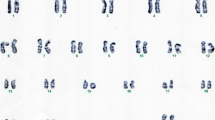Summary
Some reduction of C-segment lengths and their variability on chromsomes 1, 9, 16, and Y was exhibited by children who had had some disturbances at early stages of morphogenesis. The data obtained might suggest a certain activity of the heterochromatic regions during embryo development. Based on this data one may also suppose that reduction of the amount of heterochromatin might affect the normal morphogenetic processes.
Similar content being viewed by others
References
Angell RR, Jacobs PA (1975) Lateral asymmetry in human constitutive heterochromatin. Chromosoma51:301–310
Arrighi FE, Hsu TC (1971) Localization of heterochromatin in human chromosomes. Cytogenetics 10:81–86
Becker SM (1970) Pathology of pregnancy. [in Russian.] Medicine, Leningrad
Bloom SE, Goodpasture C (1976) An improved technique for selective silver staining of nucleolar regions in human chromsomes. Hum Genet 34:199–206
Bobrow M, Madan K, Pearson PL (1972) Staining of some specific regions of human chromsomes, particularly the secondary constriction of No 9. Nature New Biol 238:122–124
Caspersson T, Zech L, Johansson C (1970) Differential binding of alkylating fluorochromes in human chromosomes. Exp Cell Res 60:315–319
Engel W, Zenzes MT, Schmid M (1977) Activation of mouse ribosomal RNA genes at the 2-cell stage. Hum Genet 38:57–63
Evans HJ, Buckton KE, Summer AT (1971) Cytological mapping of human chromsomes. Results obtained with quinacrine fluorescence and the acetic-saline-Giemsa techniques. Chromosoma 35:310–325
Evans HJ, Gosden JR, Mitchell AR, Buckland RA (1974) Location of human satellite DNAs on the Y chromosome. Nature 251:346–347
Gagne R, Laberge C (1972) Specific cytological recognition of the heterochromatic segment of number 9 chromosome. Exp Cell Res 73:239–242
Galloway SM, Evans HJ (1975) Asymmetrical C band and satellite DNA in man. Exp Cell Res 94:454–459
Goodpasture C, Bloom SE, Hsu TC, Arrighi FE (1976) Human nucleolus organizers: the satellites or the stalks? Am J Hum Genet 28:559–566
Gosden JR, Mitchell AR, Buckland RA, Clayton RP, Evans HJ (1975) The location of four human satellite DNAs on human chromosomes. Exp Cell Res 92:148–158
Gosden JR, Laurie SS, Cooke HJ (1981) A cloned repeated DNA sequence in human chromosome heteromorphisms. Cytogenet Cell Genet 29:32–39
Jones KW, Corneo G (1971) Location of satellite and homogeneous DNA sequences on human chromosomes. Nature New Biol 223: 268–271
Jones KW, Prosser J, Corneo G, Ginelli E (1973) The chromosome location of human satellite DNA III. Chromosoma42:445–451
Jones KW, Purdom IF, Prosser J, Corneo G (1974) The chromosomal location of human satellite DNA I. Chromosoma 49:161–171
Karetnikova NA (1980) Genetical factors in the origin of unknown etiology habitual abortions and inborn malformations. [in Russian.] Thesis, Moscow 1980
Kogan RB (1971) The health of children at an early age in the Soviet Union. [in Russian.] Medicine, Moscow
Magenis RE, Donlon TA, Wyandt HE (1978) Giemsa-11 staining of chromosome 1: a newly described heteromorphism. Science 202: 64–65
Podugolnikova OA (1979) The quantitative analysis of polymorphism on human chromsomes 1, 9, 16, and Y. III. Study of relationships of C segments' lengths in individual karyotypes. Hum Genet 49: 261–268
Podugolnikova OA, Korostelev AP (1980) The quantitative analysis of polymorphism of human chromosomes 1,9, 16, and Y. IV. Heterogeneity of a normal population. Hum Genet 54:163–169
Podugolnikova OA, Sushanlo HM, Parfenova IV, Prokofieva-Belgovskaja AA (1979a) The quantitative analysis of polymorphism on human chromosomes 1, 9, 16, and Y. II. Comparison of the C segments in male and female individuals(group characteristics). Hum Genet 49:251–260
Podugolnikova OA, Sycheva JL, Prokofieva-Belgovskaja AA (1979b) The variability of the C segments' lengths of human chromsomes 1, 9, 16, and Y. [in Russian.] Cytology 21:667–670
Saunders GF, Hsu TC, Getz MJ, Simes EL, Arrighi FE (1972) Location of a human satellite DNA in human chromosomes.Nature New Biol 236:244–246
Schweizer D, Ambros P, Andrle M (1978) Modification of DAPI banding on human chromosomes with a DNA binding oligopeptide antibiotic: distamycin A. Exp Cell Res 111:327–332
Sigmund J, Schwarz S (1979) Variable substructure in the secondary constriction of the human chromosome 1. Hum Genet 46:1–4
Stahl A, Luciani JM, Devictor M, Capodano AM, Gagne R (1975) Constitutive heterochromatin and micronucleoli in the oocyte at the diplotene stage. Humangenetik 26:315–327
Author information
Authors and Affiliations
Rights and permissions
About this article
Cite this article
Podugolnikova, O.A., Blumina, M.G. Heterochromatic regions on chromosomes 1, 9, 16, and Y in children with some disturbances occurring during embryo development. Hum Genet 63, 183–188 (1983). https://doi.org/10.1007/BF00291542
Received:
Revised:
Issue Date:
DOI: https://doi.org/10.1007/BF00291542




